RESEARCH/REVIEW ARTICLE
Leadership in politics and science within the Antarctic Treaty
John R. Dudeney1
& David W.H. Walton2
1 10 Church Lane, Wilburton, Cambridgeshire, CB6 3RQ, UK
2 British Antarctic Survey, Natural Environment Research Council, High Cross, Madingley Road, Cambridge CB3 0ET, UK
Abstract
For over 50 years the Antarctic has been governed through the Antarctic Treaty, an international agreement now between 49 nations of whom 28 Consultative Parties (CPs) undertake the management role. Ostensibly, these Parties have qualified for their position on scientific grounds, though diplomacy also plays a major role. This paper uses counts of policy papers and science publications to assess the political and scientific outputs of all CPs over the last 18 years. We show that a subset of the original 12 Treaty signatories, consisting of the seven claimant nations, the USA and Russia, not only set the political agenda for the continent but also provide most of the science, with those CPs producing the most science generally having the greatest political influence. None of the later signatories to the Treaty appear to play a major role in managing Antarctica compared with this group, with half of all CPs collectively producing only 7% of the policy papers. Although acceptance as a CP requires demonstration of a substantial scientific programme, the Treaty has no formal mechanism to review whether a CP continues to meet this criterion. As a first step to addressing this deficiency, we encourage the CPs collectively to resolve to hold regular international peer reviews of their individual science programmes and to make the results available to the other CPs.
Keywords
Governance; claimant states; Antarctic policy; scientific publications
Correspondence
David W.H. Walton, British Antarctic Survey, Natural Environment Research Council, High Cross, Madingley Road, Cambridge CB3 0ET, UK.
E-mail: dwhw@bas.ac.uk
(Published: 12 April 2012)
Polar Research 2012. © 2012 J.R. Dudeney & D.W.H. Walton. This is an open-access article distributed under the terms of the Creative Commons Attribution-Noncommercial 3.0 Unported License (http://creativecommons.org/licenses/by-nc/3.0/), permitting all non-commercial use, distribution, and reproduction in any medium, provided the original work is properly cited.
Citation: Polar Research 2012, 31, 11075, DOI: 10.3402/polar.v31i0.11075
Antarctica is one of few areas of the world where science is the predominant activity and where the publications it produces can be linked to policy and political initiatives in a straightforward fashion. It is governed by international agreement and managed according to the Antarctic Treaty and its subsidiary conventions and protocols which together comprise the Antarctic Treaty System (ATS; Jacobssen 2011). Although seven nations have sovereignty claims to parts of it, and two (USA and Russia) reserve rights to make claims in the future, these are currently set aside by Article IV of the Treaty. The Treaty was signed in Washington, DC, in 1959 by 12 nations, comprising the seven claimant nations plus five others who together had undertaken substantial scientific work in Antarctica during the International Geophysical Year (1957–58). It came into force in 1961 after ratification by all signatories and now has 49 signatories (Secretariat of the Antarctic Treaty 2012) that together represent around 65% of the world population. As the Treaty developed the original Parties determined a two-tier structure: those countries that acceded and conducted substantial scientific work were classed as Consultative Parties (CPs) and those who acceded but were not active on the continent were classed as Non-Consultative Parties. Only the CPs were allowed to participate in taking decisions, including the admission of new Parties to the Treaty and their elevation to CP status (Pannatier 1994).
The motivations for agreeing an Antarctic Treaty were political not scientific, in essence calling a truce on territorial dispute and preventing the militarization of Antarctica, but the centrality of science is enshrined in the heart of the Treaty (Scully 2011). It is explicit in Article II: “Freedom of scientific investigation in Antarctica and cooperation to that end as applied during the International Geophysical Year, shall continue, subject to the provisions of the present Treaty.” The fundamental purpose of the ATS is therefore to protect the continent, and associated islands south of 60°S, as a region of peace and science. The Protocol on Environmental Protection to the Antarctic Treaty (PEP), signed in 1991 and in force from 1998, introduced a very strict environmental management regime aimed at minimizing human impact upon the continent whilst reaffirming the priority of science there. The PEP included the requirement to create a new advisory body for the ATS: the Committee for Environmental Protection (CEP), which came into being in Tromsø in 1998.
The Treaty allows any nation with an interest in Antarctica to join, but is silent on the procedure by which they may achieve Consultative status. It simply says that only those (the CPs) that can demonstrate that they are carrying out “substantial scientific research activity such as the establishment of a research station or the dispatch of a scientific expedition” (Paragraph 2 of Article IX of the Treaty) can participate in decision making. The definition of “substantial scientific research” was left deliberately vague initially, but when in 1977 Poland applied to join a procedure was needed. This was developed at a Special Antarctic Treaty Consultative Meeting and required the applicant to notify the depositary government (the USA) and provide information on its programmes, especially the scientific ones. The depositary government then circulated the information for comment by the other CPs and the government hosting the next ATCM then convened a Special Antarctic Treaty Consultative Meeting at the start of the next meeting where the application was discussed and a decision taken. Poland had included the establishment of an overwintering station as part of its bid. From then on the expectation was that such a station should be part of a bid, though the general guidelines (Brazil Ministry of External Relations 1987: paragraph 49) formulated by the CPs in 1987 only required a full description of current planned scientific programmes and of the planned means for carrying out the planned programme. In 1990 the Netherlands successfully made the case not to establish its own station on environmental grounds when it became a CP, planning to work with other countries to utilize spare capacity on their stations on an agreed basis (Pannatier 1994). Though the CPs do judge suitability on the basis of the criteria, less tangible political factors, perhaps having more to do with wider diplomatic issues than Antarctica, also appear to play a significant part. There is no formal mechanism within the Treaty for reviewing whether an existing CP continues to meet the criterion although at least one international lawyer believes that consultative status could be formally lost if research ceases (Auburn 1979). However, since the ATS works through consensus it seems highly unlikely that a CP would join a consensus calling for itself to be ejected!
The formal business of the AT is conducted only at annual meetings known as Antarctic Treaty Consultative Meetings (ATCMs) or occasional Special ATCMs. All decision making is by consensus of the CPs. For the first 16 years membership was limited to the original 12 signatories, with little apparent incentive for other countries to join. However, two factors—the attempt by the Parties to agree on a convention for the management of Antarctic mineral resources, and the possibility of conducting a review of the Treaty itself after 30 years—stimulated other countries to join and achieve consultative status.
Matters for discussion at the ATCM are raised either in the form of Working Papers (WPs), which are translated into the four Treaty languages and require debate and action, or in Information Papers (IPs) that are informative only and are neither normally translated nor necessarily discussed. All CPs and the three Observers—the Scientific Committee on Antarctic Research (SCAR), the Commission for the Conservation of Antarctic Marine Living Resources (CCAMLR) and the Council of Managers of National Antarctic Programs (COMNAP)—can table WPs whilst invited Experts, such as the International Association of Antarctic Tour Operators (IAATO) and the Antarctic and Southern Ocean Coalition (ASOC), can only table IPs.
Table 1 Counting rules for scoring the contribution by Party to each Antarctic Treaty Consultative Meeting (ATCM) policy paper.
| Counting case |
Count |
| Single party, single target (either ATCM or CEP a) |
Scores 1 |
| Single party, targeted to both CEP and ATCM |
Scores 0.5 to each target |
| Two parties, single target |
Scores 0.5 each party |
| Two parties, two targets |
Scores 0.25 to each target for each Party |
| Multiple (n) parties, one target |
First named scores 0.5, others each score 0.5/(n−1) |
| Multiple (n) parties, two targets |
First named scores 0.25 for each target others each score 0.25/(n−1) to each target |
| aCommittee for Environmental Protection. |
The ATS is undoubtedly a very successful regime for the governance of Antarctica and for fostering scientific research there. Yet there have been few attempts to assess how well it is working and how CPs individually and collectively lead and engage in its business. Recently there have been bibliometric studies of the various Parties (Dastidar & Persson 2005; Dastidar 2007; Walton 2010). However, it seems that there has not been a published study of leadership and engagement within the business of the ATCM since 1971 (Hanevold 1971), although there have been various attempts to look at the political drivers for each of the CPs (Rowland 1988; Dodds 1997). Nor has there been any study of how a CP's political engagement is related to its scientific track record in Antarctic research. In this paper we describe a quasi-quantitative method for estimating leadership within the AT, use this to compare and contrast the performance of the Parties, and finally, bring these results together with bibliometric measures of scientific output.
Our hypothesis is that the number of WPs and IPs, and the relative mix of such, that a Party puts forward to ATCMs over a period of several years is a measure of that Party's degree of leadership and engagement within the AT. We recognize that this does not provide a comprehensive measure, firstly because CPs also engage by debating/revising/blocking proposals, and secondly because we have not sought to analyse the content of individual WPs or IPs. However, we do contend that our approach does provide a very good first order measure from which significant conclusions can be drawn. In making this analysis we have opted to concentrate on the period from 1992 onwards since the PEP was signed in 1991 and came into force in 1998, providing the opportunity to compare and contrast the period of preparation to 1997 (pre-PEP) with the period from 1998 onwards (post-PEP). Also, the number of CPs does not change significantly through the period (only two Parties have achieved CP status since 1992: Bulgaria in 1998 and Ukraine in 2004) and accurate data on paper attributions are available.
Methods
It is necessary to adopt some simple counting rules to take account of papers co-authored by several Parties, and also for the post-PEP period papers that are targeted at either the CEP or the ATCM (Plenary or other Working Groups) or sometimes at both. Since, in the case of multiple Party authorship, it is usual to list Parties alphabetically our counting scheme probably disadvantages such Parties as the USA, UK and SCAR in comparison with Argentina, Australia and ASOC, but we believe such bias is small.
Since 1998, when the PEP came into force, all of the IPs and WPs presented at each ATCM are publically available in full on the website of the Secretariat of the Antarctic Treaty. Pre-PEP, we have relied on data amassed by UK members of the SCAR delegation to the ATCM and tabulations of papers available in the Annual Reports from ATCMs.
The data on peer-reviewed scientific publications are abstracted from Web of Knowledge (http://wok.mimas.ac.uk/) using “antarct*” as the keyword, following the methods of earlier work by Dastidar & Persson (2005). We also recognize that such a simple selector will disadvantage those science papers from Antarctica dealing with global phenomena such as cosmology, magnetics, ionospherics and Sun–Earth interactions where the keyword is often not included in the title, abstract or keywords and this is likely to affect at most a small number of countries, particularly Australia, UK and USA.
Results and discussion
In the distribution of the total numbers of WPs (Σnwp) produced by each party for the whole period from 1992 to 2010 (Fig. 1) the UK stands out as the strongest performer overall, closely followed by New Zealand and then Australia. These three CPs form an obvious leadership group ahead of all others and together they have produced 42% of all WPs. All are claimant states, all have a long association with Antarctic affairs, the UK in particular having been the leading nation in the early expeditions of discovery to Antarctica. The top ten Parties consist of all seven claimants, the USA, Russia (who both reserve rights to make claims) and SCAR. The claimants produce 65% of WPs whilst all 10 Parties together produce 82% of all WPs. If both IPs (Σnip) and WPs are aggregated for the whole period 1992–2010 (not shown) then the picture remains the same for the top three contributors, but for the top 10, two of the claimant CPs (France and Norway) are replaced by IAATO and ASOC, reflecting their great contribution in IPs.

Fig. 1
Total sum of Working Papers produced by each of the Parties to the Antarctic Treaty for the period 1992–2010, ordered by descending total number from the left-hand side of the plot. The figure includes the following abbreviations: SCAR (Scientific Committee on Antarctic Research), COMNAP (Council of Managers of National Antarctic Programs), CCAMLR (Commission for the Conservation of Antarctic Marine Living Resources), ASOC (Antarctic and Southern Ocean Coalition) and IAATO (International Association of Antarctic Tour Operators).
WPs clearly carry much more weight than IPs in terms of demonstrating engagement in the Treaty, as the ATCM rules require WPs to be discussed whilst IPs are discussed only on request. We have therefore compared what emphasis Parties put on the one compared with the other, using a normalized index, Rw, for each Party to demonstrate this, where

Thus, if a Party produces more WPs than IPs overall then 0<Rw≤1; while if it produces more IPs than WPs then −1≤Rw<0. Figure 2 gives the results of this analysis for the period after the PEP came into force, where the Parties are ordered with respect to Σnwp (largest at the bottom), and CEP and ATCM counts are aggregated. Only four Parties have consistently generated more WPs than IPs. All four are claimants and it is notable that the two CPs that have produced the most WPs overall fall in this group. Also, with but few exceptions, the emphasis put on producing WPs compared with IPs grows with the number of WPs produced.

Fig. 2
Normalized plot comparing production of Working Papers with that of Information Papers for the period 1998–2010. See the text for the definition of the index Rw. The figure includes the following abbreviations: IAATO (International Association of Antarctic Tour Operators), ASOC (Antarctic and Southern Ocean Coalition), CCAMLR (Commission for the Conservation of Antarctic Marine Living Resources), COMNAP (Council of Managers of National Antarctic Programs) and SCAR (Scientific Committee on Antarctic Research).
There are marked differences between the behaviour exhibited by some Parties before and after the PEP came into force in 1998, as illustrated by Fig. 3. New Zealand, Argentina and the UK have a very consistent behaviour pre- and post-PEP, Australia has become relatively more active post-PEP whilst Chile shows the opposite behaviour. The USA, Norway, France and Russia have been much more engaged post-PEP than pre-PEP. Notably, the USA produced very few WPs indeed in the pre-PEP period. SCAR, Germany and the Netherlands seem to have become less engaged. In the case of SCAR, this probably reflects the fact that its role within the Treaty has been changed by the increasing activities of the CEP post-PEP.

Fig. 3
Normalized plot of the annual average productivity (AP) of a party compared with the overall average (AA), presented separately for the period up to and including 1997 (pre-PEP) and from 1998 onwards (post-PEP). The figure shows a normalized index, RA, where RA=(AP – AA)/(AP+AA), for each of the parties ordered with respect to Σnwp (largest at the bottom), with filled bars for the post-PEP period and open bars for the pre-PEP period. A value of RA<0 indicates that the party concerned is performing less well than the average, whilst RA>0 shows a better than average performance. The figure includes the following abbreviations: IAATO (International Association of Antarctic Tour Operators), ASOC (Antarctic and Southern Ocean Coalition), CCAMLR (Commission for the Conservation of Antarctic Marine Living Resources), COMNAP (Council of Managers of National Antarctic Programs) and SCAR (Scientific Committee on Antarctic Research).
To the extent that production of WPs does represent leadership and engagement, none of the nations that acceded to the Treaty after the original 12 nations has made any major impact compared with that of the seven claimant nations, the USA and Russia. To that extent the Antarctic Treaty remains the preserve of this rather select group, all of whom have either long-term connections, claims, strong wider geopolitical or major scientific interests, or all four of these, to spur them to give relatively high priority to the Treaty. The “Imperial Three” of UK, Australia and New Zealand are clearly dominant, echoing an earlier historical context. In 1919 the British politician Leo Amery wrote on behalf of the British Government to the Governors General of Australia and New Zealand proposing that the British Empire should adopt a policy of territorial claims that would bring the whole of Antarctica under the control of the Empire (Dudeney & Walton 2011). This policy was vigorously pursued in the 1920s and into the 1930s, and though not ultimately fully successful, did bring most of the continent within the Empire. It is hence notable that these three CPs have dominated the business of the ATS consistently over the period, though they nowadays do not necessarily speak with one voice!
The 14 least involved CPs contribute fewer than 7% of the WPs. This is an interestingly heterogeneous group comprising both developed European democracies (Finland, Spain, Sweden), former Communist European states (Bulgaria, Poland, Ukraine), two of the largest economies in the world (China, Japan), major emerging economies (Brazil, Korea), three small South American states (Ecuador, Peru, Uruguay) and one of the original 12 signatories (South Africa).
Of the Observers, SCAR is clearly the leader and it should be noted that it was established prior to the birth of the Treaty and has always been its major science advisor (Walton 2011; Walton & Clarkson 2011). COMNAP (Fowler 2000) is a consistent contributor in the top half of the Parties to the Treaty, but perhaps has not had as much impact as its members might have hoped when it separated from SCAR in 1988. CCAMLR sees its role at treaty meetings as one of liaison and its input of papers reflects this passive approach.
We have given a broad picture of the CPs performance on the diplomatic stage. How does this compare with their commitment to, and productivity from, their scientific programmes in Antarctica, noting that they must demonstrate a “substantial scientific research activity”? The number of peer-reviewed publications produced by a CP is compared with its number of WPs in Fig. 4. Generally, the more engaged a CP is in the diplomacy the greater will be its output of science—which is reassuring. However, this is true only to the zeroth order and given the very disparate nature of the CPs in terms of gross domestic product, population, level of development etc. this is hardly surprising.

Fig. 4
Log/log plot of the number of Working Papers produced by all Consultative Parties compared with their output of science papers from 1992 to 2010.
The criterion to become and remain a CP is the demonstration of substantial scientific research activity. This is not a quality measure, rather it addresses quantity but in an ill-defined way. Figure 4 shows that some Parties produce almost no publications—can this be fairly represented as substantial? Furthermore, as the Dastidar & Persson (2005) results show, some CPs have a lower scientific output than several of the Non-Consultative Parties, and even nations who are not Parties at all. Though the rules of the Treaty do contain a rather general and ill-defined mechanism by which the CPs must reach consensus on whether a candidate CP qualifies, once qualified there is no mechanism for assessing whether the criterion continues to be met. As we have already noted, even if there was, consensus decision making means that there can never be a procedure for expelling a CP on the grounds that it no longer has a substantial programme. Even so, it seems very strange that the ATS, which apparently prides itself on its bedrock of science, has no formal mechanism for critical review of CPs research performance. There has been at least one suggestion at an ATCM that SCAR should be requested to review the science undertaken by all Parties in the Antarctic but SCAR has resolutely refused to accept such a potentially divisive activity (Secretariat of the Antarctic Treaty 2005, paragraphs 183b and 192). Several CPs have had independent international reviews of their Antarctic programmes carried out both to inform their policy makers and improve their science quality, but, as far as we are aware, only Finland has ever made the results of such a review public (Dudeney et al. 2006) and explicitly brought those results to an ATCM (Finland 2007). This prompted a re-evaluation of Finland's research objectives which was the subject of a further paper at the following ATCM (Finland 2008). We encourage the ATS to recommend that all CPs should have regular international peer reviews of their programmes and should make the results available to the other CPs. As a minimum, leading CPs could voluntarily follow Finland's lead to encourage the others.
In a first attempt to assess the extent of the possible costs associated with leadership in Fig. 5 the data are normalized using gross domestic product figures for 2010. This presents a very different distribution. There is still a clear correlation between scientific productivity and WP productivity, but it is now possible to draw some initial conclusions about the value for money of the investment in Antarctica for different CPs’ performance compared with their general world ranking. New Zealand stands out, putting great priority on full engagement in Antarctic affairs (but benefitting greatly from its close association with US logistics). It leads a small group of countries (Chile, Argentina, Australia, the UK and Norway), all of them claimants, that do the same. By contrast the USA is now way down the pecking order. China sits at the very bottom left hand corner of the plot. However, this may be giving a false picture as China's gross domestic product and its production of science papers has grown dramatically over the period covered, a trend which shows every sign of continuing.

Fig. 5
Log/log plot of the number of Working Papers (WPs) produced by all Consultative Parties compared with their output of science papers from 1992 to 2010, normalized by the 2010 gross domestic product (GDP) of the Consultative Parties. GDP data are for 2010 (World Bank 2011) and are in USD.
We conclude that at present the Treaty remains effectively a select club dominated by the claimant nations and the Cold War warriors (USA and Russia), and that the return on the investment in Antarctic activities in terms of significant science or political initiatives seem lacking for several countries. Further more detailed investigations seem warranted to determine how scientific investment is related to subject leadership, what are the key science papers and their effects, what regional groupings (for example South American or European countries) can do to develop particular political ideas and how Antarctic science relates to Earth System Science in an increasingly fragile world.
Acknowledgements
We are grateful to the Leverhulme Trust, the Trans-Antarctic Association and the Commissioner for British Antarctic Territory for grants to enable us to carry out this research. The comments of two anonymous reviewers are gratefully acknowledged.
References
Auburn
F.M. 1979.
Consultative status under the Antarctic Treaty. Comparative International Law Quarterly 28,
514–522.
[Crossref]
Brazil Ministry of External Relations 1987. Final report of the Fourteenth Antarctic Treaty Consultative Meeting.
Buenos Aires: Brazil Ministry of External Relations.
Dastidar
P. 2007.
National and institutional productivity and collaboration in Antarctic science: an analysis of 25 years of journal publications (1980–2004). Polar Research 26,
175–180.
[Crossref]
Dastidar
P.
&
Persson
O. 2005.
Mapping the global structure of Antarctic research vis-a-vis Antarctic Treaty System. Current Science 89,
1552–1554.
Dodds
K.
1997. Geopolitics in Antarctica: views from the Southern Ocean rim. Chichester: John Wiley.
Dudeney
J.R.,
Peltier
W.R.
&
Navarro
F.J.
2006. Antarctic research in Finland 1998–2005. International evaluation. Helsinki: Academy of Finland.
Dudeney
J.R.
&
Walton
D.W.H.
2011. From Scotia to ‘Operation Tabarin’—developing British policy for Antarctica. Polar Record, doi: 10.1017/S0032247411000520.
Finland 2007. Antarctic Research in Finland 1998–2005. International evaluation. Information Paper 3. XXX Antarctic Treaty Consultative Meeting. 30 April–11 May, New Delhi.
Finland 2008. Finland's Antarctic research strategy. Information Paper 40. XXXI Antarctic Treaty Consultative Meeting. 12–23 June 2006, Edinburgh.
Fowler
A.N.
2000. COMNAP, the national managers in Antarctica. Baltimore: American Literary Press.
Hanevold
T. 1971.
The Antarctic Treaty Consultative Meetings—form and procedure. Cooperation and Conflict 6,
183–199.
[Crossref]
Jacobsson
M. 2011. Building the international legal framework for Antarctica. In
P.
Berkman
et al. (eds.): Science diplomacy: Antarctica, science and the governance of international spaces. Pp. 1–15.
Washington,
DC: Smithsonian Institution Scholarly Press.
Pannatier
S. 1994.
Acquisition of consultative status under the Antarctic Treaty. Polar Record 30,
123–129.
[Crossref]
Rowland
J.R. 1988. The Treaty regime and the politics of the consultative parties. In
C.C.
Joyner
&
S.K.
Chopra
(eds.): The Antarctic legal regime. Pp. 11–31.
Dordrecht: Martinus Nijhoff.
Scully
T. 2011. The development of the Antarctic Treaty System. In
P.
Berkman
et al.
(eds.): Science diplomacy: Antarctica, science and the governance of international spaces. Pp. 29–38.
Washington,
DC: Smithsonian Institution Scholarly Press.
Secretariat of the Antarctic Treaty 2005. Final report of the Twenty-Eighth Antarctic Treaty Consultative Meeting.
Buenos Aires: Secretariat of the Antarctic Treaty.
Secretariat of the Antarctic Treaty 2012. The Antarctic Treaty. Accessed on the internet at http://www.ats.aq/e/ats.htm on 27 February 2012
Walton
D.W.H. 2010. Trends and patterns in Antarctic science. In
S.
Campbell
&
E.
Maloney
(eds.): Polar Libraries Colloquy 2008. Currents of change. The future of polar information. Pp. 163–176.
Edmonton: CCI Press and the Canadian Circumpolar Library, University of Alberta.
Walton
D.W.H. 2011. The Scientific Committee on Antarctic Research and the Antarctic Treaty. In
P.
Berkman
et al. (eds.): Science diplomacy: Antarctica, science and the governance of international spaces. Pp.73–88.
Washington,
DC: Smithsonian Institution Scholarly Press.
Walton
D.W.H.
&
Clarkson
P.D.
2011. Science in the snow: 50 years of international collaboration in Antarctica. Cambridge: Scientific Committee on Antarctic Research.
World Bank 2011. Gross domestic product 2010. World development indicators database. Accessed on the internet at http://databank.worldbank.org/databank/download/GDP.pdf in July 2011.